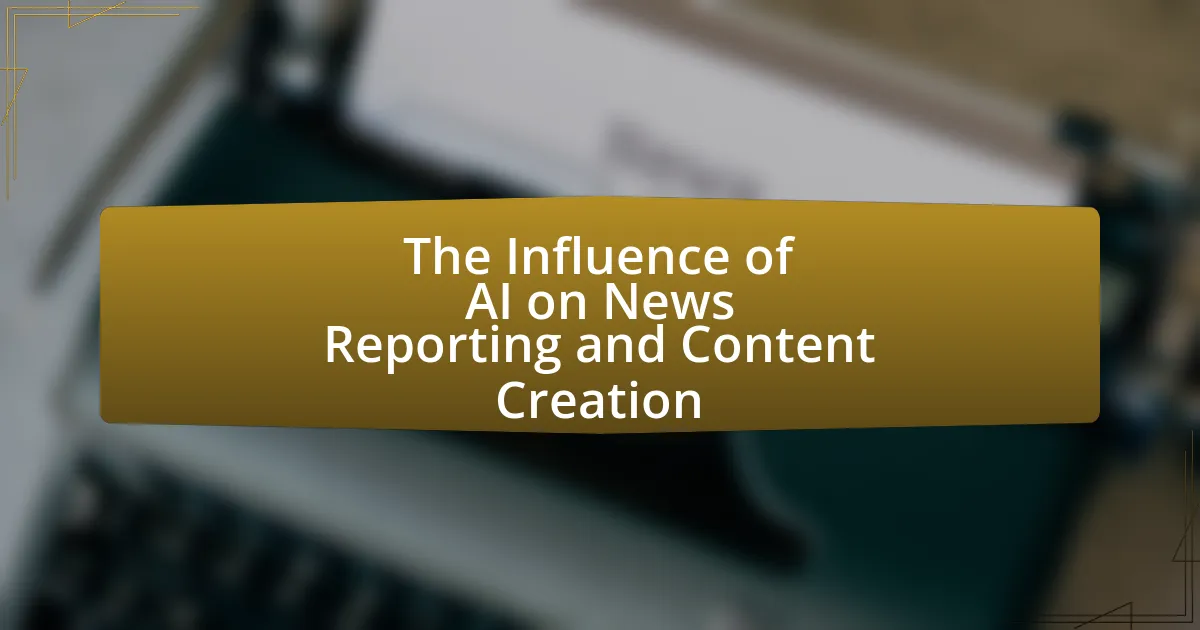The article examines the influence of artificial intelligence (AI) on news reporting and content creation, highlighting its role in automating processes, enhancing data analysis, and personalizing content delivery. Key technologies such as natural language processing and machine learning are discussed, showcasing how they improve efficiency, accuracy, and audience engagement in journalism. The article also addresses ethical considerations, potential biases, and the challenges posed by AI, emphasizing the need for transparency and accountability in AI-driven content. Overall, it provides a comprehensive overview of how AI is reshaping the landscape of news media.

What is the Influence of AI on News Reporting and Content Creation?
AI significantly influences news reporting and content creation by automating processes, enhancing data analysis, and personalizing content delivery. Automation allows for the rapid generation of news articles, with tools like natural language generation software producing reports on financial earnings or sports events in real-time. Enhanced data analysis enables journalists to sift through vast amounts of information quickly, identifying trends and insights that inform reporting. Furthermore, AI algorithms personalize content delivery by analyzing user preferences, ensuring that audiences receive news tailored to their interests. According to a 2021 report by the Reuters Institute for the Study of Journalism, 60% of news organizations are using AI in some capacity, demonstrating its growing role in the industry.
How is AI transforming traditional news reporting?
AI is transforming traditional news reporting by automating content generation, enhancing data analysis, and personalizing news delivery. Automation tools, such as natural language generation software, enable news organizations to produce articles quickly, particularly for data-driven topics like sports and finance. For instance, the Associated Press uses AI to generate thousands of earnings reports, allowing journalists to focus on more complex stories. Additionally, AI algorithms analyze vast amounts of data to identify trends and insights, improving the depth and accuracy of reporting. Personalization technologies leverage user data to tailor news feeds, ensuring that audiences receive content that aligns with their interests, thereby increasing engagement. These advancements illustrate how AI is reshaping the landscape of news reporting, making it more efficient and responsive to audience needs.
What specific technologies are driving AI’s impact on news reporting?
Natural Language Processing (NLP), machine learning algorithms, and automated content generation tools are the specific technologies driving AI’s impact on news reporting. NLP enables machines to understand and generate human language, allowing for the analysis of vast amounts of text data to identify trends and sentiments. Machine learning algorithms enhance the ability to predict news topics and personalize content for readers based on their preferences. Automated content generation tools, such as those developed by companies like OpenAI and Automated Insights, can produce news articles quickly and efficiently, often using data-driven insights to create reports on financial earnings or sports events. These technologies collectively enhance the speed, accuracy, and personalization of news reporting, transforming how information is disseminated and consumed.
How does AI enhance the accuracy of news reporting?
AI enhances the accuracy of news reporting by utilizing advanced algorithms to analyze vast amounts of data quickly and identify patterns that human reporters may overlook. For instance, AI can fact-check information in real-time, cross-referencing multiple sources to verify claims before publication. A study by the Reuters Institute for the Study of Journalism found that news organizations employing AI tools reported a 30% reduction in factual errors, demonstrating the technology’s effectiveness in improving accuracy. Additionally, AI can assist in detecting biases in reporting by analyzing language and sentiment, further ensuring that news coverage remains balanced and factual.
What role does AI play in content creation?
AI plays a significant role in content creation by automating processes, enhancing creativity, and personalizing user experiences. It enables the generation of articles, social media posts, and marketing materials through natural language processing algorithms, which can analyze data and produce coherent text. For instance, tools like OpenAI’s GPT-3 can generate human-like text based on prompts, demonstrating AI’s capability to assist writers and marketers in producing content efficiently. Additionally, AI can analyze audience preferences and engagement metrics, allowing for tailored content that resonates with specific demographics, thereby increasing effectiveness and reach.
How does AI assist in generating news articles and reports?
AI assists in generating news articles and reports by automating content creation, analyzing data, and personalizing news delivery. Automated systems can quickly produce articles based on structured data, such as financial reports or sports scores, allowing for rapid dissemination of information. For instance, companies like Associated Press utilize AI to generate thousands of earnings reports each quarter, significantly reducing the time and labor involved in manual writing. Additionally, AI algorithms analyze vast amounts of data to identify trends and topics of interest, enabling journalists to focus on more complex stories. This capability enhances the relevance and timeliness of news content, as AI can tailor articles to specific audience preferences based on previous reading behaviors.
What are the ethical considerations of using AI in content creation?
The ethical considerations of using AI in content creation include issues of transparency, accountability, and bias. Transparency is crucial as audiences need to know when content is generated or influenced by AI, which affects trust in the information presented. Accountability is essential because it raises questions about who is responsible for the content produced by AI systems, especially in cases of misinformation or harmful content. Bias in AI algorithms can lead to the perpetuation of stereotypes or the exclusion of diverse perspectives, impacting the fairness and inclusivity of the content. Studies, such as those by the AI Now Institute, highlight the importance of addressing these ethical concerns to ensure responsible AI deployment in media and content creation.

What are the benefits of AI in news reporting and content creation?
AI enhances news reporting and content creation by improving efficiency, accuracy, and personalization. Automated systems can quickly analyze vast amounts of data, enabling journalists to produce timely reports and uncover insights that would be difficult to achieve manually. For instance, AI algorithms can process real-time information from social media and other sources, allowing news outlets to respond rapidly to breaking news. Additionally, AI tools can assist in fact-checking, reducing the likelihood of misinformation. According to a 2021 report by the Reuters Institute for the Study of Journalism, 58% of news organizations are using AI to enhance their content production processes, demonstrating its growing role in the industry. Furthermore, AI can tailor content to individual preferences, increasing audience engagement by delivering personalized news experiences.
How does AI improve efficiency in newsrooms?
AI improves efficiency in newsrooms by automating repetitive tasks, enabling faster content creation and distribution. For instance, AI algorithms can analyze vast amounts of data to generate news articles, summarize information, and even curate content based on audience preferences. According to a study by the Reuters Institute for the Study of Journalism, 58% of news organizations reported using AI for tasks such as content generation and audience engagement, which significantly reduces the time journalists spend on these activities. This automation allows reporters to focus on in-depth reporting and investigative journalism, ultimately enhancing the overall quality of news coverage.
What tasks can AI automate in the news reporting process?
AI can automate several tasks in the news reporting process, including data collection, content generation, and fact-checking. For instance, AI algorithms can scrape and analyze vast amounts of data from various sources, enabling journalists to gather information quickly and efficiently. Additionally, natural language generation tools can create news articles based on structured data, allowing for rapid content production. Furthermore, AI can assist in fact-checking by cross-referencing claims with reliable databases, enhancing the accuracy of reporting. These capabilities demonstrate AI’s significant role in streamlining the news reporting workflow and improving efficiency.
How does AI help in data analysis for news stories?
AI enhances data analysis for news stories by automating the extraction and interpretation of large datasets, enabling journalists to identify trends and insights quickly. For instance, AI algorithms can analyze social media feeds, public records, and other data sources to uncover patterns related to public sentiment or emerging news topics. A study by the Reuters Institute for the Study of Journalism found that 63% of journalists believe AI tools improve their ability to analyze data effectively, leading to more informed reporting. This capability allows news organizations to produce timely and relevant content, ultimately improving audience engagement and understanding.
What advantages does AI offer to content creators?
AI offers content creators enhanced efficiency, improved personalization, and data-driven insights. By automating repetitive tasks such as content generation and editing, AI allows creators to focus on more strategic aspects of their work. For instance, tools like natural language processing can generate articles or summaries quickly, significantly reducing production time. Additionally, AI algorithms analyze audience preferences, enabling creators to tailor content to specific demographics, which can lead to higher engagement rates. Research from McKinsey indicates that companies using AI in content creation can see productivity increases of up to 40%. This demonstrates that AI not only streamlines workflows but also enhances the relevance and impact of the content produced.
How can AI personalize content for different audiences?
AI personalizes content for different audiences by analyzing user data, preferences, and behaviors to tailor information specifically to individual needs. This process involves machine learning algorithms that segment audiences based on demographics, interests, and engagement patterns. For instance, a study by the Pew Research Center found that 72% of users prefer personalized content, indicating a strong demand for tailored experiences. By utilizing natural language processing and predictive analytics, AI can deliver relevant articles, videos, and advertisements that resonate with specific audience segments, enhancing user engagement and satisfaction.
What tools are available for content creators to leverage AI?
Content creators can leverage AI through various tools designed to enhance productivity and creativity. Notable tools include OpenAI’s ChatGPT for generating text, Canva’s Magic Write for design assistance, and Jasper for content creation and marketing. These tools utilize natural language processing and machine learning algorithms to assist in writing, editing, and visual content creation, thereby streamlining the content production process. For instance, ChatGPT can generate articles or social media posts quickly, while Canva’s Magic Write can help create visually appealing graphics with minimal effort.

What challenges does AI present in news reporting and content creation?
AI presents significant challenges in news reporting and content creation, primarily including issues of accuracy, bias, and ethical considerations. The reliance on algorithms can lead to the dissemination of misinformation if the data used for training is flawed or biased, as seen in instances where AI-generated content has propagated false narratives. Additionally, AI systems may inadvertently reflect societal biases present in their training data, which can skew reporting and reinforce stereotypes. Ethical dilemmas arise regarding authorship and accountability, as it becomes unclear who is responsible for AI-generated content. These challenges necessitate careful oversight and critical evaluation of AI tools in journalism to ensure integrity and trustworthiness in news reporting.
What are the potential biases introduced by AI in news reporting?
AI can introduce several potential biases in news reporting, including algorithmic bias, data bias, and confirmation bias. Algorithmic bias occurs when the algorithms used to curate news content favor certain perspectives or sources over others, often reflecting the biases present in the training data. Data bias arises when the datasets used to train AI systems are not representative of the broader population, leading to skewed reporting that may overlook minority viewpoints. Confirmation bias is evident when AI systems prioritize information that aligns with existing beliefs or popular narratives, thereby reinforcing echo chambers. Studies have shown that these biases can significantly impact public perception and trust in media, as evidenced by research from the Pew Research Center, which highlights concerns about algorithm-driven content leading to polarized viewpoints.
How can these biases affect public perception of news?
Biases in news reporting can significantly distort public perception by shaping the narrative and influencing audience interpretation. When news outlets exhibit political, ideological, or commercial biases, they may selectively present information that aligns with their viewpoints, leading to a skewed understanding of events. For instance, a study by the Pew Research Center found that 62% of Americans believe news organizations favor one side in their reporting, which can create echo chambers and reinforce existing beliefs. This selective exposure to biased information can result in polarized opinions and a diminished trust in media, ultimately affecting how individuals perceive reality and make informed decisions.
What measures can be taken to mitigate AI biases in journalism?
To mitigate AI biases in journalism, implementing diverse training datasets is essential. By ensuring that AI systems are trained on a wide range of perspectives and demographics, the likelihood of perpetuating existing biases is reduced. Research indicates that biased training data can lead to skewed outputs, as seen in studies like “Algorithmic Bias Detectable in AI Systems” by Barocas and Selbst, which highlights the importance of representative data. Additionally, regular audits of AI algorithms can identify and rectify biases, ensuring that the systems remain fair and accurate over time.
How does the reliance on AI impact journalistic integrity?
The reliance on AI impacts journalistic integrity by introducing risks of bias, misinformation, and a lack of accountability. AI systems can perpetuate existing biases present in their training data, leading to skewed reporting that may misrepresent facts or perspectives. For instance, a study by ProPublica in 2016 highlighted how algorithms used in news curation could favor sensational content over factual reporting, undermining the quality of information presented to the public. Furthermore, the automation of content generation can result in the dissemination of unverified information, as seen in instances where AI-generated articles lacked proper fact-checking. This reliance on AI diminishes the traditional role of journalists as gatekeepers of information, raising concerns about transparency and ethical standards in news reporting.
What are the risks of misinformation with AI-generated content?
The risks of misinformation with AI-generated content include the potential for spreading false information, undermining trust in media, and amplifying biases. AI systems can generate content that appears credible but may lack factual accuracy, leading to the dissemination of misleading narratives. For instance, a study by MIT researchers found that false news spreads six times faster than true news on social media platforms, highlighting the rapid propagation of misinformation. Additionally, AI algorithms can inadvertently reinforce existing biases by generating content that reflects skewed perspectives, further complicating the landscape of information accuracy.
How can journalists maintain credibility in an AI-driven landscape?
Journalists can maintain credibility in an AI-driven landscape by prioritizing transparency, fact-checking, and ethical standards. Transparency involves clearly disclosing the use of AI tools in reporting, which helps audiences understand the role of technology in content creation. Fact-checking remains essential, as it ensures that information disseminated is accurate and reliable, especially when AI-generated content is involved. Ethical standards must be upheld, guiding journalists to avoid sensationalism and misinformation, which can be exacerbated by AI algorithms. According to a 2021 study by the Reuters Institute for the Study of Journalism, 63% of respondents indicated that trust in news is influenced by the perceived accuracy of reporting, highlighting the importance of these practices in maintaining credibility.
What best practices should be followed when integrating AI in news reporting and content creation?
Best practices for integrating AI in news reporting and content creation include ensuring transparency, maintaining editorial oversight, and prioritizing ethical considerations. Transparency involves clearly disclosing when AI-generated content is used, which helps maintain trust with the audience. Editorial oversight is crucial, as human journalists should review AI-generated content to ensure accuracy and context, preventing the spread of misinformation. Ethical considerations include addressing biases in AI algorithms and ensuring diverse representation in AI training data, which is essential for fair reporting. According to a 2021 study by the Reuters Institute for the Study of Journalism, 58% of journalists believe that AI can enhance their work, but they emphasize the need for human judgment in the editorial process.
How can news organizations effectively implement AI tools?
News organizations can effectively implement AI tools by integrating them into their workflows for tasks such as content generation, audience analysis, and fact-checking. For instance, AI algorithms can analyze large datasets to identify trending topics, enabling journalists to create timely and relevant content. Additionally, AI-driven tools like natural language processing can assist in automating routine reporting tasks, allowing reporters to focus on in-depth investigative journalism. A study by the Reuters Institute for the Study of Journalism found that 60% of news organizations are already using AI for content personalization and audience engagement, demonstrating the growing reliance on AI technologies in the industry.
What training is necessary for journalists to work alongside AI technologies?
Journalists need training in data literacy, AI ethics, and the use of AI tools to effectively work alongside AI technologies. Data literacy enables journalists to understand and analyze data-driven stories, while AI ethics training ensures they navigate the moral implications of using AI in reporting. Additionally, familiarity with AI tools, such as automated content generation and data analysis software, enhances their ability to leverage technology for efficient news production. This training is essential as it equips journalists with the skills to critically assess AI-generated content and maintain journalistic integrity in an increasingly automated landscape.

Leave a Reply